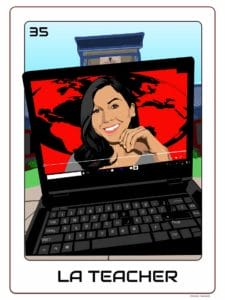
La Teacher 1 print; color ink jet; sheets 61 x 46 cm.(poster format) | Poster shows the smiling face of a teacher on a laptop computer screen. Behind her is a red globe of the world. Contributor: Ponce, Alfredo – Amplifier Date: 2020. https://lccn.loc.gov/2020632240
Devastating events of the past few years, from the Covid-19 pandemic to racism, war, and environmental crises, have been universally shared by people around the world, yet individually experienced. Reflecting on responses to these challenges can include documentation of personal and local markers of remembrance. Paying attention to such responses through writing, photography, mapping, recording, and artmaking helps us to situate ourselves and our communities in a time of global and local challenges in ways that can be healing and leave a record for others to witness.
The Library of Congress is archiving how people are expressing remembrance of current events. Posters produced through the Amplifier Art Project are one example. Based in Seattle, Amplifier is a nonprofit design studio that “builds art and media experiments to amplify the most important movements of our times.”
The Library of Congress archives many types of primary sources, including these posters. Archivists preserve materials for posterity and make them accessible by cataloging information such as the creator, date, location, size, materials, and keywords to make the archive searchable. They also digitize resources to make them available widely.
